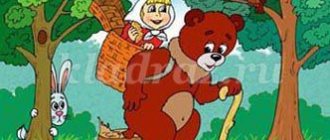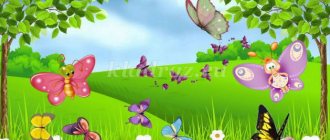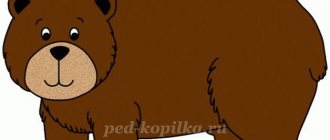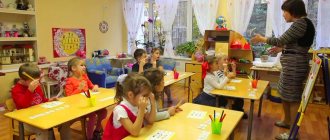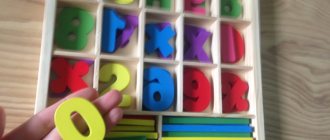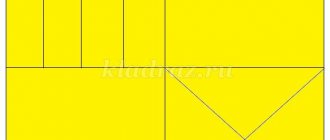Features of an open lesson in mathematics in the middle group of preschool educational institutions
Open viewing of FEMP is an effective form of organizing the pedagogical process in kindergarten. Being one of the varieties of mathematical classes, this educational activity also solves educational, developmental and educational problems.
Educational objectives in the middle group are related to the content of the program. This is counting within five, comparing objects by size (by two characteristics at once), building a serial series, getting to know new geometric shapes (rectangle), developing orientation in space, expanding time concepts. In this case, an open mathematical lesson usually touches on several of these problems at once.
The developmental tasks of an open lesson are associated with the development of the intellectual sphere of a preschooler - the processes of thinking, attention, perseverance, and the development of correct speech. At the same time, the work is organized in such a way that the child acts as a leader, takes an active position, and reveals his abilities to the maximum.
Each open mathematical lesson necessarily carries an educational value. The teacher must select a topic that will contribute to the development of positive moral qualities in the preschooler, for example, love for his native land, the desire to treat plants and animals with care, etc.
When thinking through the content and structure of an open mathematical lesson in the middle group, the teacher should focus on the following important aspects.
- Meaningful. The open viewing should become a source of innovative experience for colleagues, touching on current problems of modern methods of preschool education, as well as child psychology. An innovative approach can be expressed in the very content of visual or handout material, or in some interesting methodological technique, the use of ICT, unusual organization of space, etc. After all, showing traditional mathematical activities will not contribute to the professional growth of the specialists present.
- Social. During an open lesson, the teacher creates a situation of success for preschoolers. To achieve this, praise, encouragement, and giving the child the right to make mistakes are actively used. The teacher demonstrates the strengths of children, revealing their thinking and creative abilities.
- Pragmatic. Open viewings of FEMP are an additional incentive for cognitive activity for middle group students. They enjoy playful activities (which always accompany such events) and attention from adults.
In an open lesson with children of the fifth year of life, the following is required:
- clear organization and planning of each stage of educational activity (unlike, for example, mathematical entertainment, where the script allows improvisation);
- a mandatory intriguing start to the lesson, which will become a motivating moment for children;
- coherence and logic of the plot (usually a journey is chosen, helping a fairy-tale hero, achieving a common useful goal);
- individual approach to children (the mental and somatic development of children is different, for example, someone else has speech problems);
- original visual aids that invited teachers will be able to produce and use in their practice;
- the teacher's friendly tone, appropriate facial expressions and gestures.
In order for the open event to be successful, all planned goals are realized, the topic is revealed, the teacher needs to prepare a detailed summary (which he coordinates with the preschool educational institution methodologist). Every action of the teacher is written down there: introductory remarks, assignments, questions, comments on them during the lesson, expected answers from children, etc.
As for organizational aspects, an open mathematical lesson in the middle group is conducted without “rehearsal” and has the usual duration for this age (20 minutes). Although children of the fifth year of life are no longer babies who can cry when they see strangers, you should still psychologically prepare the children for the event, and also inform their parents about it in advance.
Guests of open viewing are always provided with workstations behind preschoolers (so that they do not distract children from cognitive activity).
At the beginning of the lesson, the teacher draws the children’s attention to the adults present and offers to say hello to them - then the kids will not look at them during the activity.
Sometimes parents are also invited to open screenings - this is useful for strengthening family relationships and gives mothers and fathers a real idea of the level of knowledge and skills of their children. In the middle group, this can be practiced, but with caution, because there are always children who can get up and go to their mother during class. In this case, work with the rest of the children should continue as usual.
Methodology for conducting an open lesson in mathematics in the middle group (structure and forms of work)
Open viewing, being a type of educational activity, has a certain structure.
- Organization and motivational beginning of a lesson that stimulates preschoolers to cognitive activity (2–3 minutes).
- Main stage. Completing tasks that reinforce certain mathematical concepts, since during an open demonstration, an explanation of new material is usually not given.
- The final stage. Summing up (2-3 minutes): the teacher asks preschoolers to share their impressions of the event, talk about what they liked most and what caused difficulties.
During an open lesson, the teacher must alternate different forms of children's activities. This will enliven the course of the lesson and allow each child to reveal the abilities. The most appropriate would be a combination of group and subgroup types.
- Collective activities: frontal survey;
- didactic games;
- physical education minutes;
- finger games;
- outdoor games with mathematical content.
Individual work is an important part of an open mathematics lesson
Summary of mathematical leisure in the middle group based on the fairy tale “Kolobok”
Author: Svetlana Aleksandrovna Russkikh, teacher, MDOU No. 68 (Belgorod )
Goal: To clarify children’s knowledge about numbers and geometric shapes. Develop operations of analysis, synthesis, classification. Foster a desire to help those who need it. To acquaint parents with the achievements of children in mastering the simplest mathematical concepts, to involve them in participating in a children's mathematical holiday.
Equipment and material: costume elements of Kolobok, Fox, Hare, Wolf, Bear, woman and grandfather. A set of cards with numbers from 1 to 5. Parts of a large construction set for building a bridge. Hoops (bumps). A paper carpet and a set of geometric shapes of different colors to decorate it. Didactic game “Collect a picture.” Ball, umbrellas, inflatable balls, wind-up toys, maple leaves, fir cones, baskets with carrots, sweets, pears.
Different clearings are being created in four different zones.
The roles of animals and kolobok are performed by parents or children and the preparatory group. During the story, the presenter helps the children answer the questions posed.
Progress:
Presenter: Babushua baked Kolobok, beautiful, rosy. It's boring for him to lie alone. And then the grandparents decided to invite guests.
Bab: You should go, Kolobok, to visit the kindergarten.
Grandfather: I would invite the guys to visit us.
Ved.: Kolobok rolled along the path and ended up in a big city, in our kindergarten.
Kolobok rolls out to the music.
Ved.: The bun looked around and began to cry.
Col.: (crying). Grandma and grandpa are waiting for the kids and me for a holiday, but I’m scared in the city - cars are driving everywhere, how will we get to the forest?
Ved.: Don’t be sad, Kolobok, we will help you. Let's all go together. We will follow this path and come out into the clearing where the hare lives.
Kolobok and the children follow the leader. A hare runs out of the forest.
Hare: Kolobok, Kolobok, I will eat you.
Ved.: Don’t eat it, bunny, my grandparents are waiting for us to visit.
Hare: Okay, I’ll let Kolobok go if you complete my tasks. Do you know all the numbers? Then listen to the first task: you need to quickly put all the numbers in order (from 1 to 5). Children complete the task.
Hare: Well done, you completed this task. Now the task is more difficult. You close your eyes, and I will hide one of the numbers. Having opened your eyes, you must determine which number is missing.
Children complete the task.
Hare: And you completed this task correctly. Now answer my questions:
- Name a number that is greater than three by one.
- Name a number that is less than four.
- Name a number less than two by one.
Children's answers.
Hare: What smart friends you have, Kolobok, they coped with all the tasks. Maybe you know poems about numbers and figures?
Children read poems on the topic.
Hare: You made me happy, you completed the assignments, and read the poems. I’ll let Kolobok go and send gifts to his grandparents (gives Kolobok a basket with carrots). Goodbye, bon voyage.
Ved.: Let's move on. There is a river on our way.
Kolobok: Oh, I’m about to drown. I can't swim at all.
Ved.: Don’t be sad, Kolobok, the guys and I will come up with something. We will now build a bridge.
They are building a bridge from the construction material. Everyone moves to the other side of the river, and the Wolf is waiting for them there.
Wolf: Hello guys! Go your way, but I’ll eat Kolobok.
Ved.: Don’t eat it, Wolf, we are all going to visit our grandparents together.
Wolf: For a visit? Well, okay, I’ll let Kolobok go if you can complete my tasks. I want you to make a beautiful pattern out of geometric shapes on my carpet.
Teamwork to decorate a paper carpet with geometric shapes.
Wolf: Well done, you decorated my carpet beautifully. We'll have to let Kolobok go with you. Give my grandparents a gift - maple leaves.
Ved: It started to rain.
Kolobok (crying): Now my legs will stick to the path, and I won’t be able to return to my grandparents.
Children offer a way out of the current situation, for example, put on a raincoat, put on boots, take an umbrella. Then the musical game “Sunshine and Rain” is played. After the game we move on.
Ved.: Guys, it seems we have entered a clearing of smart puzzles.
A bear is sitting in a clearing.
Honey: Kolobok, Kolobok, I will eat you.
Ved.: Don’t eat it, we’re going to visit our grandparents.
Honey: Complete my tasks - you will go to the holiday, but if not, I will eat it. I have magic pictures, but they are all mixed up. Can you collect them?
Game "Collect the picture."
Med.: Indeed, we did it, look how smart the guys are. But try to guess my riddles.
- Who changes clothes four times a year? (earth at different times of the year).
—
The five brothers are inseparable
They are never bored together.
They work with a pen
Saw, spoon, axe. (fingers).
Med.: Well, hurry up and visit. From me, take fir cones to your grandparents for the samovar so that the tea will be fragrant.
Ved.: Let's go, children, to the swamp.
Kolobok: How can I be lost, stuck in a swamp.
Children offer to get over the swamp, jumping from hummock to hummock (from hoop to hoop). Having crossed the swamp, they find themselves in a clearing. In the middle of the clearing, under a tree, sits a Fox.
Fox: Kolobok, Kolobok, I will eat you.
Children: Don't eat it, fox. We are going to see our grandparents.
Fox: Okay, I’ll let you go if you play with me. Stand in a circle and start a game. We will play with this ball. The game is called "On the contrary". I will say the words and throw the ball to one of you. And the one who catches the ball must say the word with the opposite meaning and return the ball back.
Children play with Fox.
Lisa: But I won’t let Kolobok go with you, I’m bored here alone.
Kolobok: If you want, come with us. Grandma will bake delicious pies and treat everyone to tea.
Lisa agrees.
Next, there is a meeting between the children and grandmother and a tea party.
A selection of ideas and author's developments according to the Federal State Educational Standard
Topic options for the middle group
The teacher can choose any topic for open viewing. Fairy-tale themes are very popular, when all tasks are played out around the plot of a specific fairy tale, well known to students in the middle group (“Teremok”, “Kolobok”, “Geese-Swans”, “The Three Little Pigs”, “Little Red Riding Hood”). Such an activity may have a name, for example, “Visiting a Fairy Tale.”
The content of educational activities can also include motifs from different fairy tales, when children travel through fairy tales, helping the heroes of each of them. This activity can be called “Journey through Fairy Tales” or “Fairytale Kaleidoscope”.
The theme for the lesson can also be the plot of a cartoon (“Three from Prostokvashino”, “Visiting Winnie the Pooh”).
An original idea is to prepare a plot play, a mini-play, where preschoolers will play the role of, for example, geometric figures, talking about themselves and their properties (“Country of Figures,” “Kingdom of Mathematics,” etc.). And during the course of such a performance, the children will be offered interesting tasks.
An open mathematical lesson can be associated with natural history topics, the study of animals, birds, insects, plants (“Mathematics in the forest”, “Pets”, “River Travel”, etc.).
On the eve of a holiday, you can introduce a holiday theme into an open math lesson and designate it, for example, as “Gifts for Moms” (with appropriate gifts - beads made of geometric shapes, etc.).
The theme of the open math lesson can be associated with International Women's Day and gift beads made of geometric shapes to mothers
Ideas for a motivating start
For middle school students, the play component of math classes is of paramount importance. It should be present from the very beginning of educational activities in order to stimulate the cognitive activity of children. In this case, the teacher can use various types of motivation.
You can start the lesson with a surprise moment - an unusual guest suddenly appears and brings interesting tasks for the children. For example, Carlson (a toy or a disguised adult or child from a preparatory group) “flies” into a group room and tells the kids that he wants to play pranks with them.
You can start the lesson with a surprise moment - the appearance of a famous fairy-tale hero
Another option is that Mishka comes to the children from the forest, who has woken up and is trying to figure out what time of year it is. While Mishka was sleeping, he dreamed of riddles, games and interesting mathematical tasks, which he brought to the children in an envelope.
The motive of helping also works well. For example, in the process of traveling through fairy tales, children help different characters out of trouble. For Little Red Riding Hood, the wolf tore the beads she was carrying as a gift to her grandmother - preschoolers lay out new ones from geometric shapes. The bear destroyed the little house, and now the forest animals have nowhere to live - the kids are building a new one.
Bunny comes to visit the guys; he has a misfortune - the house in which he lives has broken down. To help the bunny find and repair his house, you need to make your way through the forest, overcoming various obstacles.
Toy hero asks children for help
An interesting solution: a balloon appears in front of the guys, who lives in the country of Mathematics and asks to help him return home.
Doll Katya reports that March 8 is coming soon, but she doesn’t know what gift to please her mother with. Preschoolers present mathematical gifts: again, beads from geometric shapes, lay out flowers on a magnetic board, etc.
Children always happily accept the offer to travel. For example, to the magical country of Igrandia, where there are many interesting activities and entertainment (and the Umnyashka doll calls them there).
A famous fairy-tale hero, for example, Kolobok, invites the children into his fairy tale. To find themselves there, the teacher invites the children to perform “magic” actions - stand in a circle, close their eyes, clap their hands, turn around themselves.
To get into a fairy tale, you need to perform certain magical actions
Another motive that also works well with middle school students is to teach a magical character something, because he himself cannot do it. For example, Dunno comes to preschoolers and tells them that he can’t count, doesn’t recognize shapes, and asks them to teach him this. Of course, kids will happily respond to such a request, because it makes them feel important and independent.
An interesting idea is to tell the children a short fairy tale at the beginning of the lesson, which the teacher can easily compose himself. For example, a lesson dedicated to geometric shapes can start with such a magical story.
In the land of geometric shapes lived the Square and the Rectangle. Rectangle considered himself ugly and clumsy. If he stands up to his full height, he looks tall and narrow, and lying on his side, he looks fat and short. The square was proud of itself: its sides are equal, and it looks the same no matter how it turns. But one day a little girl got lost in the forest. She met the heroes and turned to them for help. The girl needed to climb higher to see where her house was. Having climbed the Square, she saw nothing. When the modest Rectangle stood up to its full height, the girl found herself very high and saw where she needed to go. Friends went to see the baby off. There was a river on their way. Square could not help the girl cross the river - he flopped into the water, and Rectangle lay on his side and turned into a bridge. The girl ran across it and ended up at home. Now the hero knew that he was a necessary and useful figure.
Illustration for a fairy tale about geometric shapes
Table: fragments of notes from open classes on FEMP in the middle group
| Author and theme of GCD | Progress of the lesson |
| Velgosha N.I. “Let's help friends” (open lesson using ICT) | The teacher informs the children that the heroes of one fairy tale came to visit them (slide with characters from the fairy tale “Teremok”). The guys go into a fairy tale (stand in a circle, close their eyes, clap their hands three times and spin around themselves). A mouse appears (slide). She will be able to get into the tower only if she completes the task. Flowers of different colors and sizes grow near the tower. For each flower you need to plant a butterfly of the appropriate size. The mouse is allowed into the house (every time the little animal is allowed into the house, a slide appears on the screen). A task to help the frog (slide) - the game “Wonderful Bag”. Children take turns taking out geometric shapes, naming them and matching them with the shapes lying on their plates. Task “Complete the figure.” Slide with a picture of a bunny. Preschoolers must count how many times the bunny will knock on the drum and show the corresponding number. Slide with a fox. She loves to dance - physical education is being held. Slide with the Wolf. There is a large lock hanging on the door of the house, the key to which has been lost. You need to lay it out from counting sticks according to the proposed pattern. Assignment from the Bear (slide). He slept for so long that he mixed up the parts of the day and believes that it is light at night and dark during the day. A word game is being played: “Finish the sentence.”
All the animals end up in the little house. Now they will live cheerfully and amicably. The children say magic words together with the teacher and find themselves back in kindergarten. The lesson is summed up: the children discuss who helped the animals and which of the animals they liked the most. |
| Maksimova E.A. “Mishutka visiting the guys” | Riddle about a bear: He slept all winter in a fur coat, sucked a brown paw, and when he woke up, he began to roar. This forest animal... (bear) A toy Bear appears, who slept all winter and cannot determine what time of year it is. He also had a dream with various mathematical games, riddles and tasks. They are in an envelope. Children guess riddles about the parts of the day:
A physical education session is held:
Mishka suggests playing the word game “Finish the Sentence”:
Mishka offers to play football: the children sit down at the tables. A sheet of green cardboard is a football field with a ball on it. As instructed by the teacher, the children place the ball in the middle of the playing field, in the upper corner on the right, etc. The task is to count four yellow sticks and think about what geometric figure can be made from them (preschoolers lay out a square). Another stick is added, the guys count to five and back. Satisfied, Mishutka leaves. |
| Kozlova I.G. “Let’s help Sharik return to the country of Mathematics” | The teacher tells the children that on the way to kindergarten she found a box. From there she takes out geometric shapes - a square, a circle and a triangle. The teacher also takes a balloon out of the box and reads a poem about it: I’m inflating a balloon. I roll it like a ball, throw it up, catch it again. I look at his form. It is round, just like a flat circle. But he is a great friend to everyone around. The same shape is an orange, a watermelon, a ball, and a tangerine. I will call the figure that I can roll a ball. It turns out there is still a note in the box. It says that the ball is lost and wants to return to its home country of Mathematics. The guys should help him. "Find the ball" task. The balloon is sad because it has no friends. You need to help him - find objects of a similar shape to him in the proposed picture. Children call a snowman, a soccer ball, a New Year's ball. Game "What's rolling?" The teacher is interested in how you can get to the country of Mathematics (train, bus, etc.). A train with square wheels is on display. An experiment is being carried out: two guys roll a ball and a cube from one line to another. Children come to the conclusion that only a ball can roll, because it has no corners. The task is in the exercise of counting to 3. Trees grow in the forest: fir trees, birches, oaks (a picture is shown). The children, as directed by the teacher, name the first tree, the second and the third. Then, on the contrary, they answer what kind of spruce, etc. A physical education session “Maple” is held: The wind quietly shakes the maple, tilts to the right, to the left: One - tilt and two - tilt, The maple leaves rustled. Individual task. Each child has a picture of three trees. You need to color the first tree red, the second yellow, and the third green. At the end of the fairy forest there is a door to the country of Mathematics. You need to pick up the keys to the lock. The children are asked to cut a strip with the image of keys and attach them to the locks with the corresponding number. Now you can read the code - 3,1,2. Now the door is open and the balloon goes to its home. |
| Gilmetdinova G.S. "Balloon Journey to the Land of Mathematics" | Riddle about a hot air balloon: My beloved warm air, You work wonders with me, And like in a wonderful fairy tale, I rise to the skies. The hot air balloon invites preschoolers to go on a journey on it. To take a seat in the basket, you need to find a chair with a geometric shape, like on the ticket (it is issued to each child). Stop "Magic Forest". Apple trees grow here. You need to count how many large and small apples are on the apple tree (5 each), collect them separately in two baskets, check their number (put the small ones under the large ones). May beetles live under the apple tree. The teacher asks to find two identical beetles. There are many Christmas trees growing in the clearing. Children must find the lowest and highest. Then it is proposed to build a serial row in height, starting with the tallest tree. Ball game. The teacher throws the ball to the preschoolers one by one, asking questions:
The next task is for the guys to count with their eyes closed how many times the bell rings (several times). A strong wind began. In order for it to subside, you need to correctly complete the task - find an extra geometric figure in the row. The wind subsides, the children in the balloon return to kindergarten. The teacher gives them balloons as a keepsake of the trip. |
